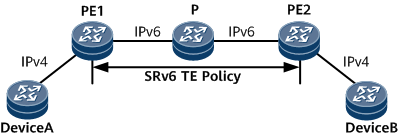Configuring Public Network IPv4 over SRv6 TE Policy
This section describes how to configure public network IPv4 over SRv6 TE Policy.
Usage Scenario
Public network IPv4 over SRv6 TE Policy uses SRv6 TE Policies on a public network to carry public network IPv4 services. The key implementation of public network IPv4 over SRv6 TE Policy includes establishing SRv6 TE Policies, advertising BGP routes, and forwarding data. As shown in Figure 1, PE1 and PE2 communicate through an IPv6 public network. An SRv6 TE Policy can be established on the IPv6 public network to carry public network IPv4 services.
Pre-configuration Tasks
Before configuring public network IPv4 over SRv6 TE Policy, complete the following tasks:
Configure a link layer protocol.
Configure network-layer addresses for interfaces to ensure that neighboring devices are reachable at the network layer.
Procedure
- Configure IPv6 IS-IS on the PEs and P. For configuration details, see Configuring Basic IPv6 IS-IS Functions.
- Establish an EBGP peer relationship between PE1 and DeviceA and another one between PE2 and DeviceB.
- Establish an IBGP peer relationship between the PEs.
- Configure basic SRv6 functions.
- Enable IS-IS SRv6.
- Configure each PE to carry color and SID attributes in public network routes to be advertised.
- Configure an SRv6 TE Policy. For configuration details, see Configuring an SRv6 TE Policy (Manual Configuration) or Configuring an SRv6 TE Policy (Dynamic Delivery by a Controller).
- Configure public network routes to recurse to the SRv6 TE Policy.
Verifying the Configuration
After configuring public network IPv4 over SRv6 TE Policy, verify the configuration.
- Run the display bgp routing-table ipv4-address [ mask | mask-length ] command to check BGP IPv4 routing table information.
Run the display segment-routing ipv6 locator [ locator-name ] verbose command to check SRv6 locator information.
Run the display segment-routing ipv6 local-sid [ locator-name ] forwarding command to check information about the SRv6 local SID table.
